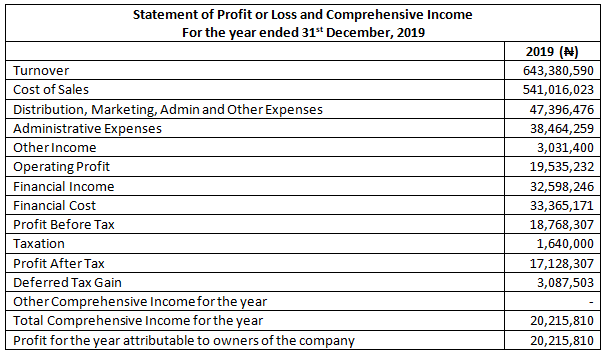In our last class, we had summarized the balance sheet, the financial statement that lets us know what our invested capital has become, and most importantly keep us informed on the safety of our investment.
In week 2, while discussing the business procedure of our friends at Obi & Ada Enterprises, we introduced the concept of a business cycle. This cycle comprises of the financing activity which is how the money for the business comes in, then the investing activity which is what becomes of the money.
The last activity is the operating activity. For Obi & Ada Enterprises, this is the act of using cash to buy farm produce from the suppliers in the village, transportation of the produce to the city, packaging the processed, semi-processed or unprocessed farm produce at their factory in the city, and then marketing & sales efforts to sell the goods to customers. When sold, the customer takes the goods and pay cash back to the company.
This activity is then repeated over and over again in the life of the company.
Read also; Wirecard AG share price fall by 99.27% in less than one year as company files for insolvency
The essence of every business is to make profit, so how does Obi and Ada know if they are making profit? They have to turn to another financial statement called the Income Statement or the Statement of Profit/Loss.
The income statement primarily focuses on the company’s revenues and expenses during a particular period. Below is the income statement of a company listed on the Nigerian Stock Exchange for the full year ended 31 December 2019. The company is involved in a similar business as Obi & Ada Enterprises.

Table 1: Extract of Income statement from a company listed on the Nigerian Stock Exchange
The first line item on this income statement is Turnover (some companies will record this as revenue), and it represents what is gotten from the sell of goods to customers in that particular period.
To arrive at the profit, all expenses will have to be subtracted from the turnover or revenue.
There are different kinds of expenses that are encountered in business and these can be broadly categorized into three.
- Operating expenses: These are the expenses incurred in the course of producing and selling the goods. These include cost of the raw materials, transportation expense, warehouse fees, cost of promotions, the sales and marketing personnel’s salaries, wages of workers involved in the processing or manufacturing of goods, depreciation of production facilities etc.
- Administration expenses: This is an expense on everything related to management. For example salaries or managers, administrative expenditures, depreciation on office etc.
- Financial expenses: This is basically interests paid on borrowings by the company.
Some companies do not follow this expenses categorization, a clear example is the financial statement we are using for our illustration. We can see cost of sales, which will contain mostly operating expenses standing alone, and then we see a range of additional operating expenses standing alone as well; distribution, marketing, admin and other expenses.
Read more; Vaxart an unpopular Biotech company shares surge over 3,000% YTD
Some companies will report Gross Profit; this is the revenue minus the operating expenses and any tax involved in selling like the Value Added Tax or any such tax that may be applicable in the country.
Going back to our illustration, we can see the administrative expenses and the financial cost (financial expenses) standing alone.
The company can earn other income as the company we are using as a case study. This “other income” can be dividend received by the company from an investment; an investment in another company or subsidiary, or investment in financial instruments etc.
A deduction of the administrative expenses from the gross profit, plus the other income will give the company’s operating profit.
Just as the company makes financials expenses, they can also make financial income. This is usually an interest on the company’s deposit at the bank.
Read further; SEC warns against iBSmartify Nigeria the promoters of iBledger and InksNation illegal products
The net financial income (financial income – financial expenses) when added to the operating profit will give the company’s Profit Before Tax. Depending on the country where it is operating, companies will be required to pay taxes on its profit.
For companies operating in Nigeria, they are required to pay a series of taxes depending on their activities; company income tax, Value-added tax, capital gains tax, education tax, personal income tax, and withholding tax, hotel occupancy and restaurants consumption tax, and stamp duty tax.
A deduction of total tax from the Profit Before Tax, will give the Profit After Tax of the company. This is the profit the company makes from its continuing operations. Some companies will call this Profit from continuing operations.
The company can also make non-operating income; such as the sell of assets, or the recognition of excess inventory, a compensation or rewards etc. As can be seen in our case study, the company had defined this income as “Other Comprehensive Income for the year”.
Just as there is non-operating income, there can also be non-operating expenses. These can be write-off of a subsidiary, loses due natural disasters, loses caused by accident etc.
Read also; Nigerians spend over 3:30 hours daily on social media – Second highest in the world
We can conclude that the non-operating income and non-operating expenses have nothing to do with the company’s operating activities. They happen by chance and don’t have continuity in the company’s plans.
It is therefore important that the income and expenses from the continuing operations are separated from the non-continuing operations.
Consider the below scenario;
- Obi & Ada Enterprises made a profit of N10 million in 2019; N9 million from continuing operations and N1 million from non-continuing operations.
- Obi & Ada Trading Ltd made a profit of N10 million in 2019; N1 million from continuing operations and N9 million from non-continuing operations.
Both companies made the same total profit in 2019, but we can all agree that Obi & Ada Enterprises will be the preferred company to invest in, as we believe it will continue making more profits in the coming years. Obi & Ada Trading Ltd made the bulk of its profit from an unusual circumstance which will likely not happen again in the years to come.
We can summarize by saying that the Income Statement does not only tell us how much profit the company made in the period, but also lists the continuous or non-continuous income separately.
In this way, based on the income statement in a period, we are able to predict the company’s future profitability.
The Income Statement therefore, does not only tell us the historical information, but also provide us the basis to predict the future profitability.
What stories can an Income Statement tell? We will find out next week.
Written by;
Nnamdi M.




















































